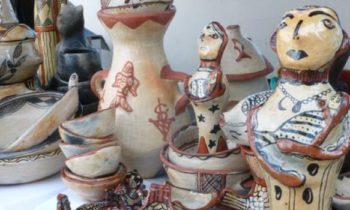
A recent exhibition-sale provided the opportunity to discover exceptional pottery pieces, bearing witness to a millennial tradition, crafted by the talented potters of Sejnane, a region in northwest Tunisia. This event took place in Tunis, within the premises of “La Villa,” a modern establishment renowned for the sale of high-end home accessories.
These Sejnane women potters actively participated in an economic interest grouping (EIG) project that led to this exhibition. The individual goal for each potter was to market 20 objects, a determination clearly visible on their welcoming faces. Adorned in festive attire, they proudly manned their booths, sheltered from the sun under tents specially set up for the occasion. With evident pride, they showcased pottery items crafted using ancestral traditional methods passed down from mother to daughter.
Interactions with exhibition visitors were lively, with the potters enthusiastically sharing their passion and expertise. Some wore traditional garments, such as red drapes secured by fibulas, accompanied by traditional jewelry. Older women proudly displayed tattoos on their foreheads, chins, and cheeks, reflecting their Berber origins and rural ties. However, it is noteworthy that younger generations of women potters are less inclined towards traditional adornments and accessories.
Sejnane pottery is a distinctive feature of the prehistoric and Roman archaeological heritage of the Kroumirie region. It represents an ancestral skill passed down through generations since antiquity, based on the exploitation of varied local raw materials, including limestone, sandstone, and red and white clay. These elements allow the creation of a paste with diverse colors and qualities.
Dyes, pigments, and varnishes used for decoration are derived from extracts of leaf oils and fruit juices provided by surrounding forests, including cork oaks, pines, carob trees, fig trees, as well as shrubs like mastic and heather.
The richness and variety of these raw materials confer a unique quality and decorative style to Sejnane pottery, setting it apart from ceramics in other regions of Tunisia.
Originally intended for daily domestic use, pottery items were traditionally crafted by women to meet their needs. Their diverse shapes, volumes, and sizes were determined by their functions, serving as kitchen utensils for food storage, cooking, beverages, serving meals, and even for lighting, such as incense burners.
The decoration of these items is characterized by a naive art, featuring stylized motifs in black and red, representing animals such as fish, birds, turtles, camels, snakes, as well as geometric patterns like checkers, broken lines, undulating, circular, and vegetal motifs, including palm trees.
Although these items are no longer part of daily and common use for them, the women potters, concerned with preserving this traditional craftsmanship, have innovated in shapes, colors, and decorations to adapt them for more contemporary uses, emphasizing decoration over domestic functionality, with the intention of commercializing them.
These items are the result of their imagination and interpretation of daily life. Some, although non-traditional, are naive sculptures, even modern and unconventional, such as female statuette dolls carrying children, others male in a predominantly black color, trinkets, as well as modernized everyday objects like tureens, bowls, and plates.
This exhibition reflects the determination of women from the rural region of Sejnane to innovate while preserving the memory of the traditional craftsmanship of their Berber ancestors. Through the creation of both utilitarian and decorative objects, shaped with imagination and creativity, they seek to adapt to the new domestic economy increasingly dependent on commercial channels.
The question remains as to whether the manufacturing techniques and traditional artisanal expertise employed by these potters will be sufficient to confer recognized quality and functionality to their molded pottery, generating interest comparable to industrially manufactured objects displayed in the windows of “La Villa.” On one hand, these elements could allow their pottery to gain distinctive recognition, and on the other hand, become a viable source of income.
Photos © Nejia-b.
5 thoughts on “The Millennial Art of the Potters of Sejnane”
Leave a Reply
You must be logged in to post a comment.


На нашем портале вам предоставляется возможность наслаждаться обширной коллекцией игровых автоматов.
Слоты обладают живой визуализацией и захватывающим игровым процессом.
Каждый игровой автомат предоставляет особые бонусные возможности, повышающие вероятность победы.
1xbet казино слоты
Игра в слоты подходит любителей азартных игр всех мастей.
Есть возможность воспользоваться демо-режимом, после чего начать играть на реальные деньги.
Проверьте свою удачу и получите удовольствие от яркого мира слотов.
This website, you can discover lots of slot machines from famous studios.
Users can experience retro-style games as well as feature-packed games with stunning graphics and interactive gameplay.
Whether you’re a beginner or an experienced player, there’s something for everyone.
money casino
All slot machines are ready to play anytime and compatible with desktop computers and mobile devices alike.
You don’t need to install anything, so you can jump into the action right away.
Site navigation is intuitive, making it quick to explore new games.
Sign up today, and dive into the thrill of casino games!
Il nostro servizio rende possibile l’ingaggio di lavoratori per compiti delicati.
Gli utenti possono scegliere operatori competenti per incarichi occasionali.
Tutti i lavoratori vengono scelti con attenzione.
assumi assassino
Sul sito è possibile leggere recensioni prima di procedere.
La fiducia rimane al centro del nostro servizio.
Esplorate le offerte oggi stesso per ottenere aiuto specializzato!
Прямо здесь можно получить Telegram-бот “Глаз Бога”, который проверить всю информацию по человеку через открытые базы.
Сервис функционирует по ФИО, используя доступные данные онлайн. Благодаря ему осуществляется бесплатный поиск и глубокий сбор по фото.
https://glazboga.net/
Наш ресурс размещает актуальные новости со всего мира.
Здесь можно найти события из жизни, технологиях и многом другом.
Новостная лента обновляется ежедневно, что позволяет всегда быть в курсе.
Удобная структура ускоряет поиск.
https://fashionsecret.ru
Каждое сообщение написаны грамотно.
Редакция придерживается достоверности.
Читайте нас регулярно, чтобы быть всегда информированными.